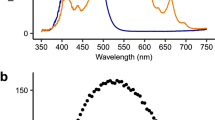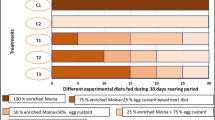Abstract
Using monospecific diets of Thalassiosira pseudonana cells grown under different steady-state conditions, it was determined that higher growth rates of larval Crassostrea gigas Thunberg were obtained when fed T. pseudonana cells grown under high light. High light grown T. pseudonana cells consistently contained relatively more of the saturated fatty acids 14:0 and 16:0. Considered over three independent experiments, high light grown T. pseudonana cells were lower in protein and higher in carbohydrate than low light grown cells. Higher growth rates of larval C. gigas were obtained on diets with more of the essential fatty acid (EFA) 22:6ω3, and less of the other EFA, 20:5ω3. The relative requirements of C. gigas larvae for the essential fatty acids 20:5ω3 and 22:6ω3 are discussed. Faster growing larvae contained higher percentages of the fatty acids 14:0 and 16:0, and lower percentages of 22:2j. Oyster growth rates were correlated with their content of the fatty acids: 14:0, 16:0 and 22:2j in two experiments utilizing separately spawned batches of larvae. Fatty acid profiles are proposed as a technique for assessing larval condition. C. gigas larvae contained ten times the percent composition of the FAs 16:4ω3, 18:1ω7, 20:1ω7 and 22:2j compared with their diet. Correlation analysis suggests that the dietary source of 18:1ω7, 20:1ω7 and 22:2j was 16:1ω7. It is concluded that T. pseudonana cells grown under high light are a superior diet for C. gigas larvae in comparison with low light grown cells of the same species.
Similar content being viewed by others
Literature cited
Ackman, R. G. (1982). Fatty acid metabolism of bivalves. In: Pruder, G. D., Langdon, C., Conklin, D. (eds.). Biochemical and physiological approaches to shellfish nutrition. Proceedings of the Second International Conference on Aquaculture Nutrition. Louisiana State Univ. Press, Baton Rouge p. 358–376
Ackman, R. G. (1986). WCOT (capillary) gas-liquid chromatography. In: Hamilton, R. J., Rossell, J. B. (eds.) Analysis of oils and fats. Elsevier Applied Science Publ, New York, p. 137–206
Ackman, R. G., Hooper, S. N. (1973). Non-methylene-interrupted fatty acids in lipids of shallow-water marine invertebrates: a comparison of two molluscs (Littorina littorina, and Lunatia triseriata) with the sand shrimp (Crangon septemspinosus). Comp. Biochem. Physiol. 46B: 153–155
Ackman, R. G., Tocher, C. S., McLachlan, L. (1968). Marine phytoplankter fatty acids. J. Fish. Res. Bd Can. 25: 1603–1620
Bayne, B. L. (1973). Physiological changes in Mytilus edulis L. induced by temperature and nutritive stress. J. mar. biol. Ass. U.K. 53: 39–58
Bligh, E. G., Dyer, W. J. (1959). A rapid method of total lipid extraction and purification. Can. J. Biochem. Physiol. 37: 911–917
Calderwood, G. S. (1989). Effects of nutrient limitation on biochemical composition of three microalgae and their consequent food value to oyster larvae, Crassostrea gigas. M.Sc. thesis, University of British Columbia, Vancouver, B.C.
Chan, A. T. (1978). Comparative physiological study of marine diatoms and dinoflagellates in relation to irradiance and cell size. I. Growth under continuous light. J. Phycol. 14: 396–402
Chu, Fu-Lin E., Webb, K. L. (1984). Polyunsaturated fatty acids and neutral lipids in developing larvae of the oyster, Crassostrea virginica. Lipids 19: 815–820
Chuecas, L., Riley, J. P. (1969). Component fatty acids of the total lipids of some marine phytoplankton. J. mar. biol. Ass. U.K. 49: 97–116
Clayton, Jr., J. R., Dortch, Q., Thoresen, S. S., Ahmed, S. I. (1988). Evaluation of methods for the separation and analysis of proteins and free amino acids in phytoplankton samples. J. Plankton Res. 10: 341–358
Cook, J. R. (1963). Adaptations in growth and division during the division cycle in synchronized Euglena gracilis. Pl. Physiol. 41: 821–825
Creekman, L. L. (1977). The effects of conditioning the American oyster (Crassostrea virginica) with Tetraselmis suecica and cornstarch on the growth, vigor and survival of its larvae. M.A. thesis, University of Virginia, Charlottesville, Virginia, U.S.A.
Dubois, M., Giles, K. A., Hamilton, J. K., Rebers, P. A., Smith, F. (1956). Colorimetric determination for sugars and related substances. Analyt. Chem. 28: 350–356
Enright, C. T., Newkirk, G. F., Craigie, J. S., Castell, J. D. (1986a). Evaluation of phytoplankton as diets for juvenile Ostrea edulis L. J. exp. mar. Biol. Ecol. 96: 1–13
Enright, C. T., Newkirk, G. F., Craigie, J. S., Castell, J. D. (1986b). Growth of juvenile Ostrea edulis L. fed Chaetoceros gracilis Schutt of varied chemical composition. J. exp. mar. Biol. Ecol. 96: 15–26
Epifanio, C. E. (1979). Grwoth in bivalve molluscs: nutritional effects of two or more species of algae in diets fed to the American oyster Crassostrea virginica (Gmelin) and the hard clam Mercenaria mercenaria (L.) Aquaculture, Amsterdam 18: 1–12
Epifanio, C. E., Valenti, C. C., Turk, C. L. (1981). A comparison of Phaeodactylum tricornutum and Thalassiosira pseudonana as foods for the oyster, Crassostrea virginica. Aquaculture, Amsterdam 23: 347–353
Falkowski, P. G., Dubinsky, Z., Wyman, K. (1985). Growth-irradiance relationships in phytoplankton. Limnol. Oceanogr. 30: 311–321
Flaak, A. R., Epifanio, C. E. (1978). Dietary protein levels and growth of the oyster Crassostrea gigas. Mar. Biol. 45: 157–163
Fogg, G. E. (1965). Algal cultures and phytoplankton ecology. Univ. Wisconsin Press, Madison, Wisconsin
Gabbott, P. A., Bayne, B. L. (1973). Biochemical effects of temperature and nutritive stress on Mytilus edulis L. J. mar. biol. Ass. U.K. 53: 269–286
Gallager, S. M., Mann, R. (1982). The effect of varying carbon/nitrogen ratio in the phytoplankter Thalassiosira pseudonana (3H) on its food value to the bivalve Tapes japonica. Aquaculture, Amsterdam 26: 95–105
Gallager, S. M., Mann, R. (1986). Growth and survival of larvae of Mercenaria mercenaria (L.) and Crassostrea virginica (Gemlin) relative to broodstock conditioning and lipid content of eggs. Aquaculture, Amsterdam 56: 103–121
Gallager, S. M., Mann, R., Sasaki, G. C. (1986). Lipid as an index of growth and viability in three species of bivalve larvae. Aquaculture, Amsterdam 56: 81–103
Harrison, P. J., Thompson, P. A., Calderwood, G. S. (1990). Effects of nutrients and light limitation on the biochemical composition of phytoplankton. J. Applied Phycol. 2: 45–56
Harrison, P. J., Waters, R. E., Taylor, F. J. R. (1980). A broad spectrum artificial seawater medium for coastal and open ocean phytoplankton. J. Phycol. 16: 28–35
Holland, D. L. (1978). Lipid reserves and energy metabolism in the larvae of benthic marine invertebrates. In: Malins, D. C., Sargent, J. R. (eds.) Biochemical and biophysical perspectives in marine biology, Vol. 4. Academic Press, New York, p. 85–123
Holland, D. L., Spencer, B. E. (1973). Biochemical changes in fed and starved oysters Ostrea edulis during larval development, metamorphosis and early spat growth. J. mar. biol. Ass. U.K. 53: 287–298
Klingensmith, J. S. (1982). Distribution of methylene and nonmethylene interrupted dieonic fatty acids in polar lipids and triacylglycerols of selected tissue of the hardshell clam (Mercenaria mercenaria). Lipids 17: 976–981
Kowallik, W. (1978). Blue light effects on carbohydrate and protein metabolism. In: Senger, H. (ed.) Blue light responses: phenomena and occurences in plants, Vol. 1. CRC Press, Boca Raton Florida, p. 8–13
Langdon, C. J., Waldock, M. J. (1981). The effect of algal and artificial diets on the growth and fatty acid composition of Crassostrea gigas spat. J. mar. biol. Ass. U.K. 61: 431–448
Lewin, J. C., Guillard, R. R. L. (1963). Diatoms. A. Rev. Microbiol. 17: 373–414
Lowry, O. H., Rosebrough, N. J., Farr, A. L., Randall, R. J. (1951). Protein measurement with the Folin phenol reagent. J. biol. Chem. 193: 265–275
Mann, R. (1979). Some biochemical and physiological aspects of growth and gametogenesis in Crassostrea gigas (Thunberg) and Ostrea edulis L. grown at sustained elevated temperatures. J. mar. biol. Ass. U.K. 59: 95–100
Marsh, J. B., Weinstein, D. B. (1966). Simple charring method for the determination of lipids. J. Lipid Res. 7: 574–576
Morris, I. (1982). Photosynthetic products, physiological state and phytoplankton growth. In: Platt, T. (ed.), Physiological bases of phytoplankton ecology. Can. Bull. Fish. aquat. Sciences 210: p. 83–102
Orcutt, D. M., Patterson G. W. (1974). Effect of light intensity upon lipid composition of Nitzschia closterium (Cylindrotheca fusiformis). Lipids 9: 1000–1003
Parsons, T. R., Stephens, K., Strickland, J. D. H. (1961). On the chemical composition of eleven species of marine phytoplankters. J. Fish. Res. Bd Can. 18: 1001–1016
Ricketts, T. R. (1966). On the chemical composition of some unicellular algae. Phytochem. 5: 67–76
Sargent, J. R., Whittle, K. J. (1981). Lipids and hydrocarbons in the marine food web. In: Longhurst, A. R. (ed.) Analysis of marine ecosystems. Academic Press, London, p. 491–533
Shifrin, N. S., Chisholm, S. W. (1981). Phytoplankton lipids: interspecific differences and effects of nitrate, silicate and light dark cycles. J. Phycol. 17: 374–384
Sukenik, A., Carmeli, Y., Berner, T. (1989). Regulation of fatty acid composition by irradiance level in the Eustigmatophyte Nannochloropsis sp. J. Phycol. 25: 686–692
Thompson, P. A., Guo, M-X., Harrison, P. J., Whyte, J. N. C. (in press). Influence of temperature on the fatty acid composition of marine phytoplankton. J. Phycol.
Thompson, P. A., Harrison, P. J., Parslow, J. S. (1991). Influence of irradiance on cell volume and carbon quota for ten species of marine phytoplankton. J. Phycol. 27: 351–360
Thompson, P. A., Harrison, P. J., Whyte, J. N. C. (1990). The influence of irradiance on the fatty acid composition of phytoplankton. J. Phycol. 26: 278–288
Utting, S. D. (1986). A preliminary study on growth of Crassostrea gigas larvae and spat in relation to dietary protein. Aquaculture, Amsterdam 56: 123–138
Volkman, J. K., Jeffrey, S. W., Nichols, P. D., Rogers, G. I., Garland, C. D. (1989). Fatty acid and lipid composition of 10 species of microalgae used in mariculture. J. exp. mar. Biol. Ecol. 128: 219–240
Waldock, M. J., Nascimento, I. A. (1979). The triacylglycerol composition of Crassostrea gigas larvae fed on different diets. Mar. Biol. Lett. 1: 77–88
Walne, P. R. (1963). Observations on the food value of seven species of algae to the larvae of Ostrea edulis. 1. Feeding experiments. J. mar. biol. Ass. U.K. 43: 767–784
Walne, P. R. (1974). The culture of bivalve molluscs: 50 years of experience at Conwy. Fishing News, West Byfleet
Watanabe, T., Kitajima, C., Fujita, S. (1983). Nutritional values of live organisms used in Japan for mass propagation of fish: a review. Aquaculture, Amsterdam 34: 115–134
Webb, K. L., Chu, F-L.E. (1982). Phytoplankton as a food source for bivalve larvae. In: Pruder, G. D., Langdon, C., Conklin, D. (eds.) Biochemical and physiological approaches to shellfish nutrition. Proceedings of the Second International Conference on Aquaculture Nutrition. Louisiana State Univ. Press, Baton Rouge, p. 272–291
Wilson, J. H. (1978). The food value of Phaeodactylum tricornutum Bohlin to the larvae of Ostrea edulis L. and Crassostrea gigas Thunberg. Aquaculture, Amsterdam 13: 313–323
Whyte, J. N. C. (1988). Fatty acid profiles from direct methanolysis of lipids in tissue of cultured species. Aquaculture, Amsterdam 75: 193–203
Whyte, J. N. C., Bourne N., Hodgson, C. A. (1989). Influence of algal diets on biochemical composition and energy reserves in Patinpecten yessoensis (Jay) larvae. Aquaculture, Amsterdam 78: 333–347
Author information
Authors and Affiliations
Additional information
Communicated by R. O'Dor, Halifax
Rights and permissions
About this article
Cite this article
Thompson, P.A., Harrison, P.J. Effects of monospecific algal diets of varying biochemical composition on the growth and survival of Pacific oyster (Crassostrea gigas) larvae. Marine Biology 113, 645–654 (1992). https://doi.org/10.1007/BF00349708
Accepted:
Issue Date:
DOI: https://doi.org/10.1007/BF00349708




